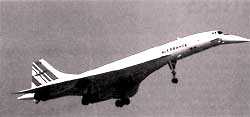Airborne enemies
 another addition to the list of products harmful to the ozone layer is the Concorde, the supersonic aircraft. Research shows that the trail of invisible fog of sulphuric acid left by a Concorde may be depleting the ozone layer far faster than climatologists had expected. David Fahey of the us government's National Oceanic and Atmospheric Administration, Colorado, found higher than expected levels of sulphuric acid, in the form of a very fine aerosol, in the samples of exhaust emissions from a Concorde.
another addition to the list of products harmful to the ozone layer is the Concorde, the supersonic aircraft. Research shows that the trail of invisible fog of sulphuric acid left by a Concorde may be depleting the ozone layer far faster than climatologists had expected. David Fahey of the us government's National Oceanic and Atmospheric Administration, Colorado, found higher than expected levels of sulphuric acid, in the form of a very fine aerosol, in the samples of exhaust emissions from a Concorde.
Earlier, researchers had believed that most of the sulphur that burns in aircraft engines forms sulphur dioxide. Once in the atmosphere, it gets converted to sulphuric acid and condenses onto particles in air, without affecting vital stratospheric chemical processes. But in the case of a Concorde, the burnt sulphur comes out as sulphur trioxide which converts faster to sulphuric acid. In the absence of enough particles in the atmosphere on which to condense, the acid creates a fog of tiny new particles. These particles provide a surface for chlorine pollutants, which destroy ozone.
